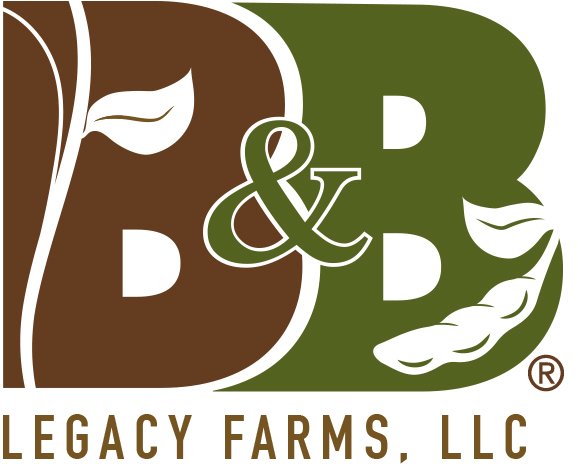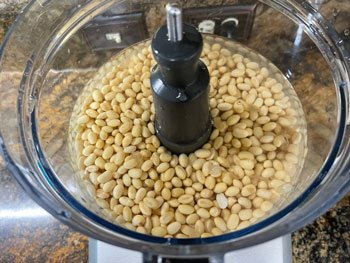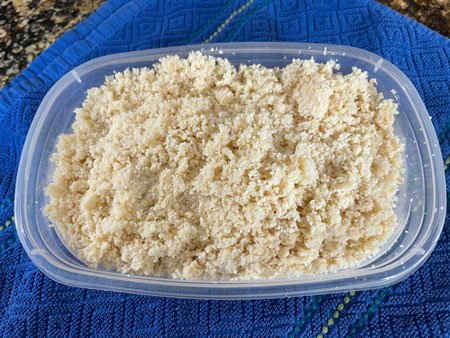March Recipe of the Month: B&B’s Rich Soy Milk Recipe
Top 5 Tips for
Soy Milk Making!
Start with the right soybean!
I learned the importance of the soya variety from the pros and three years of experimenting in my home kitchen.
The bean absolutely makes a difference. Always use a yellow soybean with a clear hilum like our SouthernSoy® variety.
SouthernSoy® was the hands-down winner in a blind taste test conducted using a range of soy varieties.
Making soy milk only involves 3-4 ingredients and 4 steps:
Soaking the beans
Grinding the beans
Cooking the beans
Straining the beans
Tip #1. Start the day before. Don’t rush the soaking (at least 8 hours).
Tip #2: Get your instruments ready!
You will need a tall/large stock pot. Cheesecloth or a straining cloth is critical for a smooth milk. A colander alone won’t give you the best results. Make sure your metal colander fits in or on top of your straining pot or can stand inside another pot for filtering the hot soy slurry. A pressing tool will be your 2nd best friend. Look around your kitchen and be creative! An old-fashioned potato masher works great!
Tip #3: Boil over alert!
You won’t believe how much foam ground soybeans can produce while cooking. A heat-proof spatula with a LONG handle to keep the foam at bay will be your friend. Don’t start without one.
If your soy milk threatens to boil over while cooking remove the pot from the burner for a brief period and reduce the heat before returning the pot to the burner. Have a couple of good pot holders standing at ready!
Tip #4: Decide what you want to do with the okara.
The bean fiber remaining in the cheesecloth/straining bag is the soy milk lees by-product of soy milk production known as okara (soy pulp). Cooked okara can be used as an ingredient in baking. See okara nutritional information and cooking resources at the end of the recipe.
You can also just throw it away.
Tip #5: Want to make soy cream for your coffee?
If you want to make soy cream reduce the water in this recipe and just add water for the milk portion.
This is a simple recipe that can and should be adjusted for your personal taste preferences. Experiment to find your ideal recipe.
Enjoy!
~Karen
B&B’s Rich Soy Milk Recipe
Soak Time: 8-12 hours
Cook Time: 1 ½ hours
INGREDIENTS:
2 cups of SouthernSoy® yellow dry soybeans
8-9 cups of water
½-1 teaspoon of vanilla
1-2 Tablespoons of agave nectar or honey
Dash of salt (optional)
Directions:
Prep: Day before or early morning.
Rinse soybeans in a colander (remove any foreign matter and/or discolored beans).
Soak soybeans 8-12 hours. Cover with water (4 times their volume) in a large glass bowl or stainless-steel pot, cover with a lid, and soak overnight or all day. Dried beans double in volume and weight after soaking. If your dry beans are current season, soak them in the refrigerator to prevent sprouting.
Drain the water and rinse the soybeans following the soak. Set soybeans aside to strain in the colander.
Get your instruments ready!
Cheesecloth/muslin/straining cloth
Large food processor or blender
Large/Tall stock pot
Metal Colander
2nd pot to strain milk into (optimally the colander sits inside the pot with the handles bracing the colander on the rim or with legs that fit inside the pot).
Large spatula (with a long handle)
A pressing tool. This can include a potato masher or other clean heat-proof jar or heavy spoon. You need a “pressing tool” to press the straining cloth containing hot soybean slurry (in the colander).
Silicon gloves might help but are not required.
Step 1: Set up processing, cooking, and straining stations. Begin processing.
Place rinsed/strained soybeans in food processer.
Add 3 cups of water to processor then blend/puree for about 3-4 minutes. Add more water if needed. Blend until smooth.
Step 2: Cook the soybean slurry.
While processing the soybeans, add 5 ½ cups of water to the pot and heat on medium high heat.
Pour the pureed soybeans into the cooking pot.
Rinse the processor with ½ cup of water and add to pot.
Stir frequently while soy milk is cooking to prevent burning.
Heat until boiling and reduce heat to low and cook for 7 more minutes.
Watch the foam! Keep your potholders handy.
You may need to move the pot off the burner from time to time to prevent the foam from boiling over.
Remove from the burner and let soy milk cool for a few minutes.
Step 2: Straining.
Oops! I spilled some soy slurry over the side!
Spread the muslin or cheesecloth inside the colander, lapping the edges of the cloth over the upper rim of the colander.
Place the colander in a second pot.
Pour the hot soy milk into the colander, up to the upper edges of the straining cloth. Let the milk strain into the 2nd pot. Gradually add the remainder of the hot milk and let strain and cool for 5 minutes.
Burn alert! Be careful. Take your time.
Pull the muslin/cheesecloth/ sides up and twist upper ends together to form a bag. Once the bag is cool, gather up and twist and squeeze the bag, releasing milk through the colander into the pot.
Use a pressing tool to press more milk from the bag.
When the bag seems dry, open the bag, add ½ cup of water and squeeze and press again a second time.
NOTE: I am showing pictures of the different strainer set-ups I have used.
The bean fiber remaining in the bag is the soy milk lees by-product of soy milk production known as okara (soy pulp). See okara nutritional information and cooking resources below. *
Step 3: Cook your soy milk a second time.
Cook the soy milk on medium for 20-25 minutes, stirring constantly.
Add agave nectar/honey, vanilla, and salt and stir well during the last 10 minutes of cooking.
Remove from heat and let cool. I sometimes strain the milk one final time.
Store your soy milk in a sealed container and refrigerate. I like to use clear glass canning jars with a lid.
Soy milk stays fresh up to 3-5 days in the refrigerator. This simple recipe has no preservatives or artificial thickeners, unlike store-bought soy milk.
Soy Milk Nutrition Facts: Serving Size: 1 cup.
Calories: 100; Total Carbohydrates: 7g; Protein: 7g; Dietary Fiber: 2g; Calcium: 380 mg; Iron: 1.2mg; Total Fat: 4.9g; Saturated Fat: .41g; Cholesterol: 0; Sodium: 96 mg; Potassium: 289 mg.
Source: USDA
NOTES:
Okara, a byproduct from making soy milk is rich in natural fiber, calcium, and protein. One-hundred grams (1/2 cup) of okara contains 11.5g of fiber. Okara can be frozen for future use.
*Cooked okara can be used as an ingredient in baking.
“Okara is low in calories, high in dietary fiber and calcium content, and retains about 40% of boiled soybean protein. The dietary fiber in okara is cellulose which is not water-soluble. This cellulose fiber aids the workings of the intestinal tract helping to relieve constipation. Okara is also rich in carbohydrates and potassium. The abundant oligosaccharides contained in soybean carbohydrates nourish the friendly bacteria in the gut.”
Source: http://www.tofu-as.com/english/nutrition_facts/01effects/02.html
Japan Tofu Association
Want to learn more about how to use okara?















